-

人教版新目标初中英语八年级下册What were you doing when the UFO arrived教案2篇
(一).知识方面: 1.培养学生能运用过去进行时来描述、谈论过去某个时间正在发生的事情或动作的意识和能力,能就过去某个时间正在发生的动作做出正确的描述。 2.培养学生的想象力和角色扮演的合作能力。 3.培养学生讲述过去发生的事情经过的能力。能正确运用一般过去时来讲述故事。 (二).技能方面: 1.本单元的语言目标是Talk about past events and tell a story(谈论过去的时间和讲述一个故事),围绕这一目标,要涉及句型: What were you doing when the UFO arrived? ----I was sitting in the barber’s chair. The barber was cutting my hair. 因此必须学习standing、studying、cleaning、sleeping、cooking、making、eating、cutting、等表示地点的词,以便为上述句型提供语言材料。2.学习过去进行时的有关知识。Was/were+现在分词,是该时态的表达式。 3.在学习过程中,要区分The boy was walking down the street when the UFO landed.和While the boy was walking down the street, the UFO landed.这两种由when和while引导的状语从句的句型结构。注意它们的不同。

人教版新目标初中英语八年级下册Why don’t you get her a scarf教案
教师带领学生复习有关描述宠物的词汇,采用教师提问学生回答的方进行。如:T:What animals do you think would be good pets?What animals do you think would be bad pets?What do you think are good animals for a six-year-old child?然后学生进行 pairwork 练习。Task two: 师生互动,学习探究 1、播放3a部分的录音,引导学生一边听录音,一边跟读。2、通过听录音学生回答以下问题:Why do you think pot-bellied pigs are popular?What are the advantages and disadvantages of keeping such a pet?教师对学生的回答进行及时点评。3.学习范文,学习重点短语,为下步的模仿写作提供语言素材。T :1. )Have you ever kept a pig as a pet?Do you like pigs? St.:No.…Why don’t you like to keep a pig? St: No.They’re too dirty and lazy(Do you know in some foreign countries like Hollyland, Australia,pigs are the most popular pet.there’s a kind of pig.(图)it has an interesting name? it ‘s called a pot-bellied pig.) Now,let’s learn an article about this kind of interesting pet.2.)play the tapeSt.:Listen and repeat3.)show some Qs on computer(本子St.: read silently,then answerthe Qs(本子)4.)Ask ss. Close book and retell this passage.(what is a pot-bellied pig? Is it a good or bad pet? ) St.: retell it to each other“A pot –bellied pig is a popular pet now…”5.read the article together.St.:.practice reading

人教版新目标初中英语八年级下册Would you mind turning down the music教案
Step 4. Group work (4)1. Ask a pair of students to read the dialogue. Say, This activity provides speaking, listening and writing practice using the target language.2. Ask students to complete the work in groups.3. Check the answers with the whole class. 4. Explain some of the language points. Step 5. Word review (Self check 1)1. Ask students to read the words and the phrases given. 2. Fill in the blanks with proper forms of these words to complete the sentences. 3. Check the answers with the whole class. Homework:Do activity 2 on page 57 after class. Period 6Teaching aims: 1. Teach vocabulary words and the useful expressions. 2. Enable the students to learn etiquette in different culture. 3. Help the students learn how to behave politely in public places and in daily life. Teaching procedures:Step 1. RevisionHelp students to review the function of making requests through a free talk. Then lead them to the topic of etiquette. Explain the meaning of etiquette. Or, ask students to look it up in the dictionary. Step 2. Pre-reading (Section 1)1. Ask students to read the picture and make a list with their partner about how many rules of etiquette can be seen being broken.

人教版新目标初中英语九年级下册By the time I got outside, the bus had already left教案
Ⅰ. Teaching Aims and Demands1. Knowledge Objects(1) Key Vocabularyoversleep(2) Target LanguageWhat happened?I overslept. And by the time I got up, my brother had already gotten in the shower.2. Ability Objects(1) Teach the students to use the new words.(2) Train the students to narrate past events with the Past Perfect Tense.(3) Train the students' listening and speaking skills with the target language.3. Moral ObjectIt’s a good habit to go to bed early in the evening and get up early in the morning. So you’ll never be in a hurry in the morning.Ⅱ. Teaching Key Points1. Key Vocabularyoversleep2. Target LanguageNarrate past events with the Past Perfect TenseⅢ. Teaching Difficult Points1. Train the students to narrate past events with the Past Perfect Tense.2. Train the students to understand the target language in spoken conversation.Ⅳ. Teaching Methods1. Thinking of examples from the students' real lives.2. Making sentences by looking at the pictures.Ⅴ. Teaching AidA tape recorderⅥ. Teaching ProceduresStep I Revision1. Revise the language points in Unit 8.Ask some questions like this: What volunteer work would you like to do?Help the students to answer, I’d like to…/I love to…/I hope to2. Practice the dialogue in Activity 3c on page 62 again. Get students to role play the similar dialogues with the following.

人教版新目标初中英语九年级下册Rainy days make me sad教案
1. 教材分析本单元以how do things affect you?为话题, 从颜色、天气、音乐、广告、产品等方面谈论了外界事物如何影响人的心情。要求学生掌握表达某物或某事给人带来的感觉、看法或影响等。共设计了四个部分的内容:Section A 该部分有4个模块:第一模块围绕Which restaurant would you like to go to?这一话题展开思维(1a)、听力(1b)、口语(1c)训练;第二模块围绕How does music affect you? 进行听力(2a-2b)、口语训练(2c);第三模块继续围绕how do colors in the restaurant affect you这一话题展开训练,训练形式为阅读和问题体验(3a)和小组活动(3b);第四模块仍就How do things affect you这一话题以调查的形式展开讨论。Section B该部分有4个模块:第一模块围绕产品广告对人们的影响这一话题以“配对”(1a)与“列举”(1b)两种形式展开训练;第二模块继续围绕How do things affect you? 进行听力(2a-2b)、口语对话训练(2c);第三模块围绕“Advertising”这一话题展开阅读(3a-3b)和写作(3c)训练;第四模块围绕How posters affect you这一话题以口语训练形式展开小组活动。

人教版新目标初中英语九年级下册Could you please tell me where the restrooms are教案
Step Ⅰ RevisionCheck homework. Ask a few students to read the article in 3a.Then ask a few students to read their guides.Step Ⅱ Part 1Look at the words in the box. Ask a student to read them. Make sure the students understand the meaning of the words. You are to fill in the blanks with the words. In some cases, students may need to use another form of the word, for example adjusting for tense or subject/ verb agreement.Ask students to fill in the blanks on their own.Check the answers. Step ⅢPart 2Go through the instructions with the class.Look at the example with the students.Ask students what the answer would be.Ask a student to read the question and answer it.Excuse me, could you tell me where the bank is, please?The bank is across the street from the shopping malt.Get students to complete the work in pairs.Check the answers. Ask a few students to read their questions.Step Ⅳ Just for Fun!Ask all the students to read the conversation. Ask: What is funny about this cartoon? Help students to explain. A Martian is a person from the planet Mars.There is no such thing as Martian food on Earth, and the clerk looks silly because he is trying to think of where there is a Martian restaurant.Invite some pairs of students to present this conversation to the rest of the class.Step Ⅴ Summary and HomeworkIn this class, we’ve done much writing practice using the key vocabulary words and the target language presented in this unit. After class, please finish the questions in 2 in your exercise books. Then finish the exercises on pages 47~48 of the workbook as well.The Seventh Period Ⅰ Teaching Aims and Demands1. Knowledge Objects(1) Key Vocabularyimage, adventure, jealousy, hero, crime, journey, brave, no longer, show interest in, take it easy, become interested in, plain looks(2)Text:Grown-ups like cartoons, too.2. Ability Objects(1) Fast-reading to get a general idea of the text.(2) Careful-reading to get the detailed information in the text.

人教版新目标初中英语九年级下册I’ll help clean up the city parks教案
Talk about offering help (P60)I’ll help clean up the city parks.A: I’d like to work ...B: You could help ...Talk about ways to tell people about the Clean-Up Day (P61)We need to ...We can’t ...I’ll ...Talk about the work the volunteers do (P62)These three students all volunteer their time to help other people.Somebody loves to ... / helps ... / plans to ... / wants to ...A: What do you like doing?B: I like ... A: What kind of volunteer work do you think I could do?B: You could ...1. 重点词汇advertisement, fix, repair, pleasure, blind, deaf, shut, carry, specially, fetch2. 认读词汇hunger, homeless, cheer, clean-up, sign, establish, major, commitment, elementary, veterinarian, coach, similar, call-in, strategy, disabled, organization, unable, support, appreciate, donation, part of speech, pronoun, adverb, preposition, conjunction, donate, Jimmy, Sally3. 词组clean up, cheer up, give out, put off, set up, think up, take after, fix up, give away, put up, hand out, work out, at once

人教版新目标初中英语九年级下册We’re trying to save the manatees教案2篇
本单元主要围绕着有关濒临灭绝的动物这一话题,学习了应该怎样保护我们的环境,以及就某一问题展开辩论。目标提示语言目标能够运用所学知识,就某一问题展开辩论。认知目标1、复习一些语法:现在进行时、一般现在时、用used to 表示一般过去时、现在完成时、一般过去时的被动语态。2、学会表达同意和不同意。3、学会以下基本句型:We’re trying to save the manatees.Manatees eat about 100 pounds of food a day.There used to be a lot of manatees.In 1972,it was discovered that they were endangered.Some of the swamps have become polluted.情感目标了解一些濒临灭绝的动物的生活习性和濒临灭绝的原因,教育学生应该如何保护环境。教学提示充分利用多媒体等教学设备,创设与本课话题相关的情境,如各种不同种类的动物、动物园以及有关环境的画画等等。围绕着本单元的教学目标,设计一些贴近学生实际的教学任务,如让学生谈论自己最喜欢的动物,如何拯救濒危动物,如何保护环境等等。让学生根据所学知识,就动物园是否对动物有利以及其他的话题进行辩论。

人教版新目标初中英语九年级下册You’re supposed to shake hands教案
教学目标:1. 掌握本单元一些重点词汇的写法和用法。2. 学会自如谈论餐桌礼仪。Step 1 RevisionAsk some students to retell the customs at the table in France in the passage in 3a.Step 2 Self checkPart 1. Fill in each bland with the correct word given. Students do the exercises by themselves at first. Then check the answers. Ask the students to comprehend the sentences and help them point out uses of some words, like “arrive (at / in) sw., spend time / money on sth , spend time / money (in) doing sth.”Part 2. Read about Fan Ling’s experience in a western restaurant. Understand the passage. Point out some key points in the passage.1. be / get used to doing sth. 习惯做某事2. begin with = start with 以….开头3. crowd v. 挤满,塞满 the crowd 人群 crowded adj. 拥挤的Then students discuss about how she would solve her problem. Ask some to share their stories with others.Part 3. Complete the crossword by looking at the sentences on the left. Then check the answers.
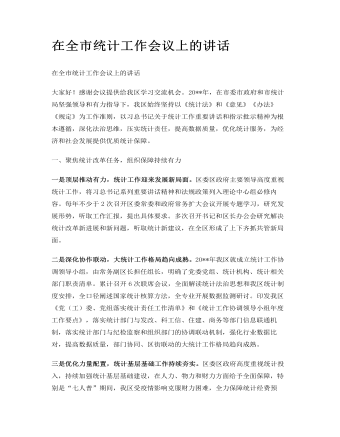
在全市统计工作会议上的讲话
重创新勤思考,完成国家投入产出试点任务。为论证统筹开展经济普查与投入产出调查的可行方法,国家统计局在全国选取6个省份开展专项试点工作,我区被选为辽宁省两个试点县区之一,采取选聘调查员方式入户调查。在国家和省市局的有力指导下,我区严格按照试点工作要求,以发现问题、解决问题、反映问题为工作抓手,以提出建议和积累经验为核心脉络,坚持组织推动和专业指导同步、过程把控和数据质量兼顾,先后开展4场业务培训,创新性设计带有审核规则的电子报表,高质量完成国家和省市统计局领导专题调研,完成149家调查单位1513张调查表数据质量审核工作,形成了2万余字的试点工作报告,圆满完成试点各项任务,并得到国家、省、市局领导高度评价。

中班语言教案:秋天果子多(诗歌)
2.体验边手工粘贴边念儿歌的乐趣;3.乐意用普通话大胆、清楚地朗诵儿歌。活动重点:用普通话大胆、清楚的朗诵儿歌。活动难点:注意个别孩子在边手工粘贴边念儿歌的困难。活动准备:1.盘子一个2.各种水果
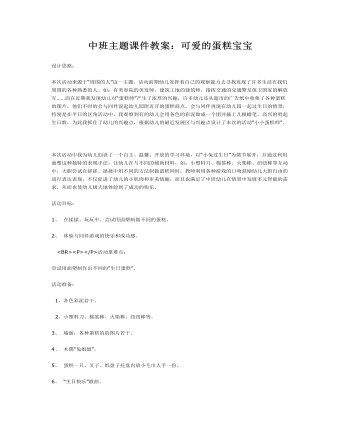
中班主题课件教案:可爱的蛋糕宝宝
本次活动中我为幼儿创设了一个自主、温馨、开放的学习环境,以“小兔过生日”为情节展开,并通过利用面塑这种独特的表现手法,让幼儿在与不同的辅助材料,如:小塑料刀、棉签棒、火柴棒、纽纽棒等互动中,大胆尝试在搓搓、揉揉中用不同的方法制做蛋糕同时,教师利用各种游戏的口吻鼓励幼儿大胆自由的进行表达表现,不仅促进了幼儿的小肌肉和审美情趣,而且也满足了中班幼儿在情景中发展多元智能的需求,从而也使幼儿极大地体验到了成功的快乐。 活动目标:1、 在揉揉、玩玩中,尝试用面塑制做不同的蛋糕。
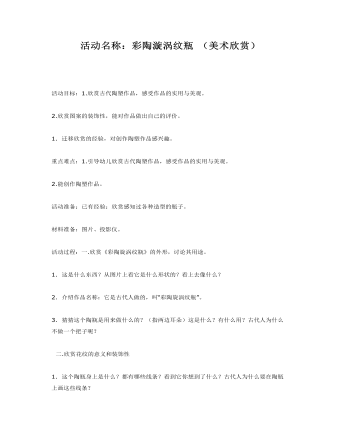
中班主题课件教案:彩陶漩涡纹瓶
2.欣赏图案的装饰性,能对作品做出自己的评价。1. 迁移欣赏的经验,对创作陶塑作品感兴趣。重点难点:1.引导幼儿欣赏古代陶塑作品,感受作品的实用与美观。2.能创作陶塑作品。活动准备:已有经验:欣赏感知过各种造型的瓶子。材料准备:图片、投影仪。
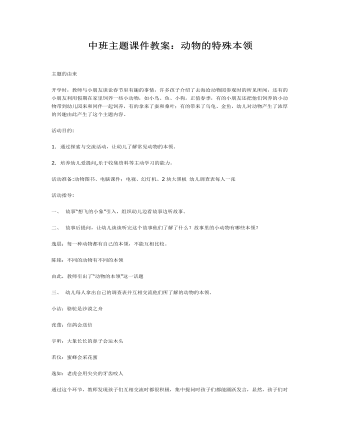
中班主题课件教案:动物的特殊本领
活动目的:1. 通过探索与交流活动,让幼儿了解常见动物的本领。2. 培养幼儿爱提问,乐于收集资料等主动学习的能力。活动准备:动物图书、电脑课件;电视、幻灯机、2块大黑板 幼儿调查表每人一张活动指导:一、 故事“想飞的小象”引入,组织幼儿边看故事边听故事。二、 故事后提问,让幼儿谈谈听完这个故事他们了解了什么?故事里的小动物有哪些本领?逸晨:每一种动物都有自己的本领,不能互相比较。陈铭:不同的动物有不同的本领由此,教师引出了“动物的本领”这一话题三、 幼儿每人拿出自己的调查表并互相交流他们所了解的动物的本领。小洁:骆驼是沙漠之舟张蕾:信鸽会送信宇昕:大象长长的鼻子会运木头若仪:蜜蜂会采花蜜逸如:老虎会用尖尖的牙齿咬人通过这个环节,教师发现孩子们互相交流时都很积极,集中提问时孩子们都能踊跃发言,显然,孩子们对“动物的本领”这个话题是十分有兴趣的。
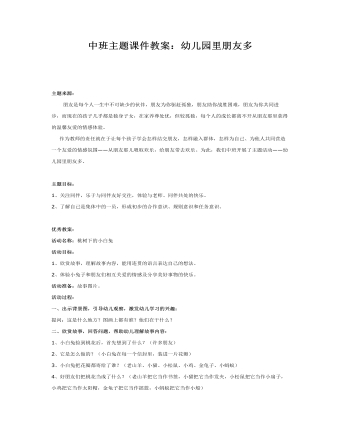
中班主题课件教案:幼儿园里朋友多
主题目标:1、关注同伴,乐于与同伴友好交往,体验与老师、同伴共处的快乐。2、了解自己是集体中的一员,形成初步的合作意识、规则意识和任务意识。 优秀教案:活动名称:桃树下的小白兔活动目标:1、欣赏故事,理解故事内容,能用连贯的语言表达自己的想法。2、体验小兔子和朋友们相互关爱的情感及分享美好事物的快乐。活动准备:故事图片。活动过程:一、出示背景图,引导幼儿观察,激发幼儿学习的兴趣:提问:这是什么地方?图画上都有谁?他们在干什么?二、欣赏故事,回答问题,帮助幼儿理解故事内容:1、小白兔捡到桃花后,首先想到了什么?(许多朋友)2、它是怎么做的?(小白兔在每一个信封里,装进一片花瓣)3、小白兔把花瓣都寄给了谁?(老山羊、小猫、小松鼠、小鸡、金龟子、小蚂蚁)4、好朋友们把桃花当成了什么?(老山羊把它当作书签,小猫把它当作发夹,小松鼠把它当作小扇子,小鸡把它当作太阳帽,金龟子把它当作摇篮,小蚂蚁把它当作小船)
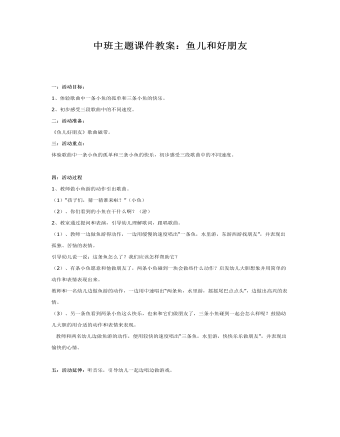
中班主题课件教案:鱼儿和好朋友
2、初步感受三段歌曲中的不同速度。二:活动准备:《鱼儿好朋友》歌曲磁带。三:活动重点:体验歌曲中一条小鱼的孤单和三条小鱼的快乐,初步感受三段歌曲中的不同速度。 四:活动过程1、教师做小鱼游的动作引出歌曲。(1)“孩子们,猜一猜谁来啦?”(小鱼)(2)、你们看到的小鱼在干什么啊?(游)2、教室通过提问和表演,引导幼儿理解歌词,跟唱歌曲。(1)、教师一边做鱼游得动作,一边用缓慢的速度唱出“一条鱼,水里游,东游西游找朋友”,并表现出孤独、苦恼的表情。引导幼儿说一说:这条鱼怎么了?我们应该怎样帮助它?
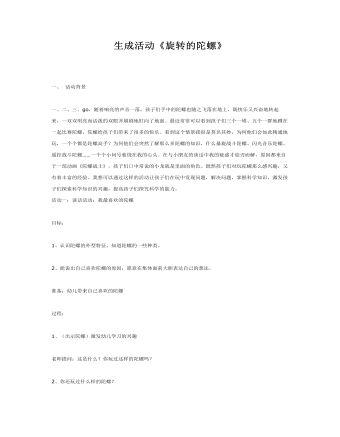
中班主题课件教案:方案活动旋转的陀螺
孩子们口中常说的小龙就是里面的角色。既然孩子们对玩陀螺那么感兴趣,又有着丰富的经验。我想可以通过这样的活动让孩子们在玩中发现问题,解决问题,掌握科学知识,激发孩子们探索科学知识的兴趣,提高孩子们探究科学的能力。活动一:谈话活动:我最喜欢的陀螺目标:1、认识陀螺的外型特征,知道陀螺的一些种类。2、能说出自己喜欢陀螺的原因,愿意在集体面前大胆表达自己的想法。准备:幼儿带来自己喜欢的陀螺过程:1、(出示陀螺)激发幼儿学习的兴趣老师提问:这是什么?你玩过这样的陀螺吗?2、你还玩过什么样的陀螺?徐晟:我玩过拧的陀螺,尤志浩:我玩过木头的陀螺,也叫打不死陀螺;周杰:我玩过装电池有按扭的陀螺,邵未龙:我见过遥控陀螺,很厉害的;周舟:我玩过有发条的陀螺……(评析:这样的谈话可以让孩子了解到陀螺的种类有很多:木头的,塑料的,拧的,有发条的,自动的。)3、你喜欢什么样的陀螺?为什么?郁幸娴:我喜欢音乐发光战斗陀螺,因为它会发出火星;戚奔:我喜欢白虎陀螺,因为它很厉害,可以打败龙陀螺;吕新炜:我喜欢大的陀螺,因为它可以转很长的时间;邵未龙:我喜欢小的陀螺,因为它转的速度很快;邹蓉蓉:我喜欢牵牛陀螺,因为它很好玩;蒋钰:我喜欢铁的陀螺,因为不容易坏……(评析:孩子对陀螺真的是爱不释手,又有过玩的经验,所以在讲的时候能充分表达自己的理由。由于孩子的知识能力有差异,所以喜欢的原因也各不相同。由此可见,我们的谈话内容一定要围绕孩子已有的经验进行。)4、如果让你设计一个陀螺,你想设计一个什么样的陀螺呢? 我想设计一个彩色的陀螺,我想设计一个喷火的陀螺,我想设计一个很厉害的陀螺,我想要一个会飞的陀螺……(评析: 从孩子们的谈话中可以看出他们喜欢陀螺的原因很多,有的是因为动画中的角色厉害他就喜欢那个陀螺,有的是因为转得快,有的是因为转得稳,也有的是因为色彩或图案漂亮。通过与同伴的交流小朋友对陀螺的种类也多了一些了解。那为什么摇摇晃晃旋转的陀螺不会倒下,为什么陀螺旋转的时候会有的快有的慢呢,其中有什么奥秘呢?)
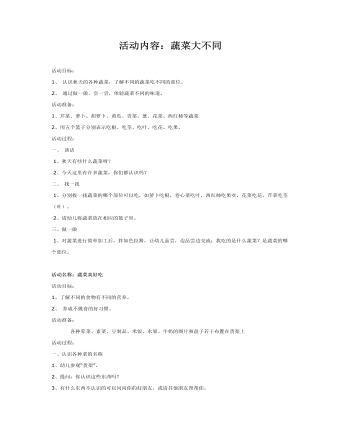
中班健康:蔬菜主题大全课件教案
2、通过做一做、尝一尝,体验蔬菜不同的味道。活动准备:1、芹菜、萝卜、胡萝卜、黄瓜、青菜、葱、花菜、西红柿等蔬菜2、用五个篮子分别表示吃根、吃茎、吃叶、吃花、吃果。活动过程:一、谈话 1、秋天有些什么蔬菜呀? 2、今天这里有许多蔬菜,你们都认识吗?二、找一找 1、分别找一找蔬菜的哪个部位可以吃,如萝卜吃根,卷心菜吃叶,西红柿吃果实,花菜吃花,芹菜吃茎(叶)。 2、请幼儿将蔬菜放在相应的篮子里。三、做一做 1、对蔬菜进行简单加工后,拌如色拉酱,让幼儿品尝,边品尝边交流:我吃的是什么蔬菜?是蔬菜的哪个部位。

人教版新课标PEP小学英语三年级下册At the zoo教案3篇
(二) 呈现新课 (Presentation)1、教师出示学过的缩略语PRCUKCANUSA让孩子读一读,然后拿出相应的卡片贴在黑板上请掌握较好的学生带着同学们读一读缩略语2、出示课文中的缩略语,让孩子们自己试着读一读,然后试着说说缩略语的含义3、听录音,跟读。小组说说4、让孩子们介绍自己收集的生活中的缩略语教师给以适当的扩充:CCTVWTOUFO等5、教师分别出示大小写Hh,让孩子想想大小写的字母分别想什么,用语言描述或是用动作表示。6、Let’s chant听录音,边听边打节奏听录音,边听边出示相应的字母听录音,边听边试着说歌谣孩子们带上自己的头饰,在小组中边演边说各小组展示(三)趣味操练(Practice)1、listen and order the cards让孩子说字母,按照听到的顺序排列字母2、listen and guess教师拼一拼缩略语,孩子快速说出词小组游戏(四) 扩展性活动(Add-activities)纸牌游戏两个孩子分别有一套学过的字母卡,按顺序出卡片,看谁能最先组成一个学过的缩略语。【板书设计】
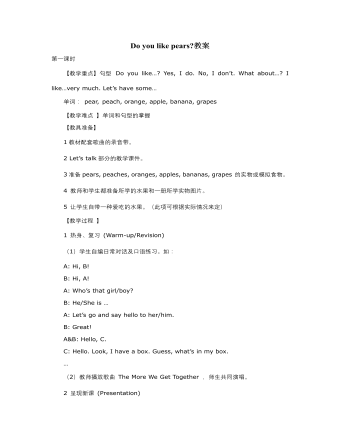
人教版新课标PEP小学英语三年级下册Do you like pears教案
教师扮做客人,让孩子根据问题做出反应并回答。 Can I have an apple? Can I have some grapes? Let’s sing 播放歌曲的录像,先观看一遍, 帮助孩子理解歌曲。 孩子边唱边表演。 小组表演,小组展示。 (四) 扩展性活动(Add-activities) Coloring Draw some grapes, color them red Draw a banana,color it green. …, …【板书设计 】Do you like pears? Do you like pears? 第五课时第六课时【课题】Do you like pears? 第六课时 【教学重点】听、说、认读字母Rr Ss Tt,体会字母在单词中的发音 【教学难点 】字母Ss的发音。Tiger中字母I的发音 【教具准备】 1、本课生词的单词卡片 2、配套的教学课件 3、相配套的教学录音带 4、学生的小英语练习本 5、大字母卡片,每组一套的小字母卡片 【教学过程 】 (一)热身/复习(Warm-up/Revision) 1、Let’s sing 演唱B部分的歌曲,边唱边演。

